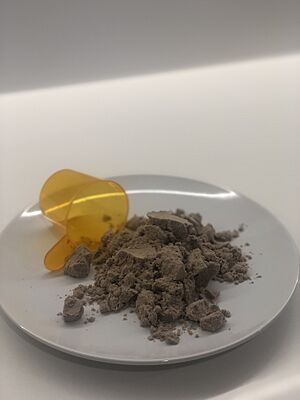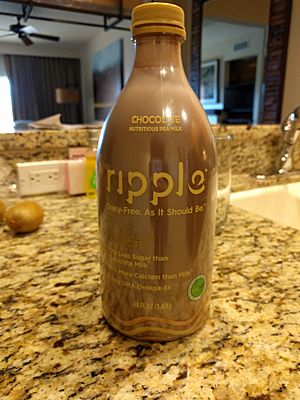Pea protein facts for kids

Chocolate flavoured pea protein powder
|
Pea protein is a food product made from yellow and green split peas. It is a popular way to add more protein to your diet. People use it as a dietary supplement or as a replacement for other foods, like pea milk instead of dairy milk. As a powder, it is also used in making many foods. It can act as a thickener, a foaming agent, or an emulsifier.
Pea protein comes in a powder form. It can be made in different ways:
- As an isolate – This process makes a powder with a very high protein level.
- As a concentrate – This process makes a powder with a lower protein level.
- In a textured form – This is used in foods to replace other ingredients, like in meat alternatives.
Pea protein is a good food source because it is easy to find, does not cause many allergies, and is very nutritious. It is a common type of plant food protein.
Some people have concerns about pea protein. These include its taste, how it affects digestion, and its salt content. Depending on how it is made, pea protein can contain certain natural compounds. These might cause minor side effects, like making it harder for your body to absorb nutrients.
Contents
What's Inside Pea Protein?
Pea protein is full of good things like protein and carbohydrates. It also has vitamins and minerals, and it is low in fat. The amount of protein in peas can change. This depends on the type of pea and where it grows.
Peas usually have a lot of protein (about 23-31%). They also contain a small amount of fat (about 1.5-2%). Other parts include vitamins, minerals, and fiber. Pea protein is almost a "complete protein". This means it has almost all the important building blocks (called essential amino acids) that your body needs. It is only a little low in two of these building blocks, called cysteine and methionine.
Pea seeds have a lot of carbohydrates (about 60-65%). Most of these are starch, which is how the pea stores energy.
Peas are also rich in dietary fiber. This fiber helps your body in many ways. The amount of fiber in dry peas can be different, depending on the type of pea.
Pea seeds also have some sugars, like sucrose and raffinose. They contain a small amount of fat, mostly healthy fats like oleic acid and linoleic acid.
Peas are a good source of important minerals and vitamins. These include folic acid, riboflavin, pyridoxine, and niacin.
How Pea Protein Is Used
As a Dietary Boost
Pea protein has many good nutrients. It can help people who need more of certain nutrients. For example, it can help those who want to add more protein to their diet. Peas are an excellent source of protein, carbohydrates, fiber, minerals, vitamins, and other helpful plant compounds.
As a Food Swap
Pea protein can be used instead of other protein sources. This is great for people who cannot eat common foods that cause allergies. These common allergens include wheat, peanuts, eggs, soy, fish, tree nuts, and milk. Pea protein can be used in baking or cooking to replace these common allergens. It is also used to make plant-based foods. These include alternative meat products and non-dairy items like pea milk.
As a Special Ingredient in Food
Pea protein is also used in food factories. It is a low-cost ingredient that makes food more nutritious. It also helps improve the way food feels and looks. For example, it can make food thicker or help it mix better. Pea protein can also create stable foams. This is useful in foods like cakes, souffles, and whipped toppings.
How Pea Protein Is Made
Making pea protein involves taking the protein out of the peas. Then it is cleaned and dried. The process starts by cleaning and splitting the peas.
Cleaning the Peas: Special machines are used to clean the peas. This removes any dirt or other seeds. It is important to remove things like wheat or barley. This makes sure the pea protein is gluten-free.
Splitting the Peas: After cleaning, the peas are split open. A machine called a dehuller removes the outer shell.
More Processing: Once split, the peas are processed further. They can be turned into starch, protein, or flour.
Pea protein can be made using two main methods:
- The wet method; and
- The dry method.
Wet Method for Pea Protein Isolate
The wet method makes pea protein isolates. These have a very high protein content. In this method, the protein is taken out using water. Other parts of the pea, like carbohydrates, are also removed. The protein is then separated and dried. This final drying step is called spray-drying.
Dry Method for Pea Protein Concentrate
The dry method makes pea protein concentrates. This method uses dry milling technology. It grinds the peas into a fine flour. Then, air is used to separate the smaller protein parts from the larger starch or fiber parts. This method is better for the environment. It uses less water and energy to dry the protein.
Pea Protein and Your Health
Nutrition Benefits
The good things about pea protein come from its starch, protein, fiber, vitamins, minerals, and other plant compounds.
Pea protein has a lot of fiber. Fiber helps control blood sugar levels. It can also help keep your heart healthy and lower blood pressure. Because it has so much fiber, pea protein is easy to digest. This means it causes fewer stomach problems like gas or bloating.
Pea proteins also have high levels of folate. This can help people get enough folate in their diet. Folate is good for people with certain blood conditions and for healthy development.
Building Muscles
Pea protein can be used to help build muscle. Eating more protein can help your muscles grow stronger over time. Pea proteins also have special building blocks called branched-chain amino acids (BCAAs). These include leucine, isoleucine, and valine, which are important for muscle growth.
Managing Weight
Pea protein can help you feel full. This is because it has a lot of protein and fiber. These can slow down how fast food leaves your stomach. They also help control hormones that make you feel hungry.
Good for the Planet
Making pea protein uses fewer resources than making some other proteins. For example, it uses less water and fertilizer than making whey or soy protein. This makes pea protein a more environmentally friendly food choice. One study showed that getting one kilogram of animal protein needs six kilograms of plant protein. Another study found that making eggs, chicken, or milk uses 1.5 times more water per gram of protein than making peas. For beef, it uses six times more water!
Things to Consider About Pea Protein
Taste
Some people do not like the taste of pea protein. It can have a slightly bitter or metallic taste. This is because it contains a natural compound called saponins.
Texture
Depending on how it is made, pea protein can sometimes feel a bit gritty.
What's Inside
How pea protein is processed can affect what it contains. Some pea proteins might have natural compounds that can cause minor side effects. These compounds might make it harder for your body to digest protein or absorb important minerals like iron, zinc, and calcium.
See also
- Pea milk
- Soy protein
- Bodybuilding supplement
- Whey protein


